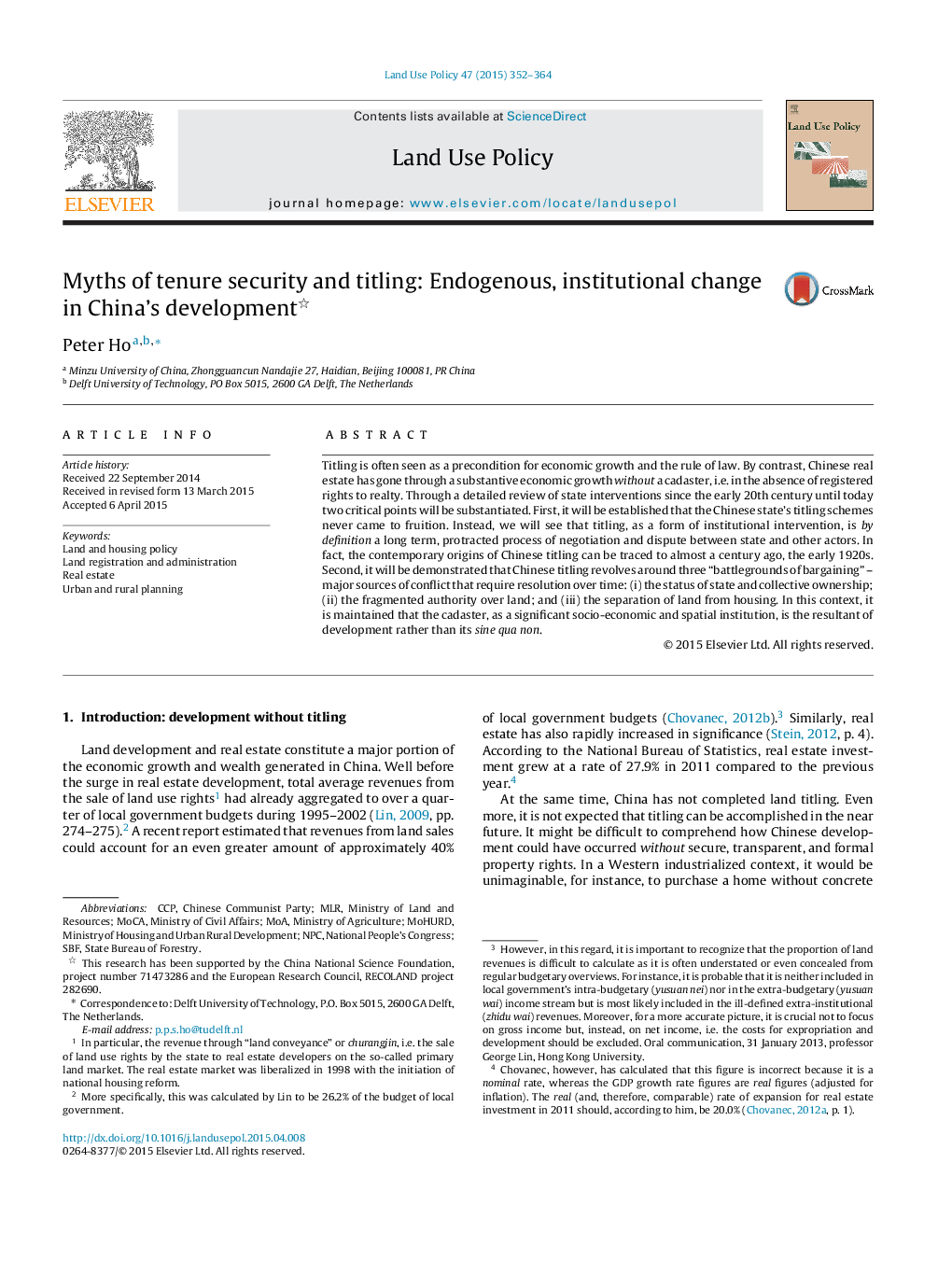| کد مقاله | کد نشریه | سال انتشار | مقاله انگلیسی | نسخه تمام متن |
|---|---|---|---|---|
| 6548153 | 160098 | 2015 | 13 صفحه PDF | دانلود رایگان |
عنوان انگلیسی مقاله ISI
Myths of tenure security and titling: Endogenous, institutional change in China's development
ترجمه فارسی عنوان
اسطوره های امنیتی و تعهدات قانونی: تغییرات اندوخته و نهادی در توسعه چین
دانلود مقاله + سفارش ترجمه
دانلود مقاله ISI انگلیسی
رایگان برای ایرانیان
کلمات کلیدی
ترجمه چکیده
تالیف اغلب به عنوان پیش شرطی برای رشد اقتصادی و حاکمیت قانون دیده می شود. در مقابل، املاک و مستغلات چینی بدون رشد اقتصادی رشد کرده است بدون اینکه یک مرتکب اشتباه باشد، یعنی در غیاب حقوق ثبت شده در املاک. از طریق ارزیابی دقیق مداخلات دولت از اوایل قرن بیستم تاکنون، دو نقطه بحرانی به اثبات رسیده است. اولا تاسیس خواهد شد که طرح های حقوقی دولت چینی هرگز به نفع خود نیست. در عوض، ما شاهد خواهیم بود که عنوان بندی، به عنوان یک نوع مداخله نهادی، به صورت تعریف یک پروسه طولانی مدت، طولانی مدت مذاکره و اختلاف بین دولت و سایر بازیگران است. در حقیقت، ریشه های معاصر چینی چینی را می توان تقریبا یک قرن پیش از اوایل دهه 1920 کشف کرد. دوم، نشان داده خواهد شد که تقاضانامه چینی در اطراف سه میدان جنگ چانه زنی متضاد است؟ - منابع اصلی جنگ که نیاز به حل و فصل در زمان: (1) وضعیت مالکیت دولتی و جمعی؛ (2) قدرت تقسیم بر زمین؛ و (3) جدایی زمین از مسکن. در این زمینه، حفظ شده است که کاداستر، به عنوان یک نهاد مهم اجتماعی-اقتصادی و فضایی، ناشی از توسعه است و نه به معنای سومی آن.
موضوعات مرتبط
علوم زیستی و بیوفناوری
علوم کشاورزی و بیولوژیک
جنگلداری
چکیده انگلیسی
Titling is often seen as a precondition for economic growth and the rule of law. By contrast, Chinese real estate has gone through a substantive economic growth without a cadaster, i.e. in the absence of registered rights to realty. Through a detailed review of state interventions since the early 20th century until today two critical points will be substantiated. First, it will be established that the Chinese state's titling schemes never came to fruition. Instead, we will see that titling, as a form of institutional intervention, is by definition a long term, protracted process of negotiation and dispute between state and other actors. In fact, the contemporary origins of Chinese titling can be traced to almost a century ago, the early 1920s. Second, it will be demonstrated that Chinese titling revolves around three “battlegrounds of bargaining” - major sources of conflict that require resolution over time: (i) the status of state and collective ownership; (ii) the fragmented authority over land; and (iii) the separation of land from housing. In this context, it is maintained that the cadaster, as a significant socio-economic and spatial institution, is the resultant of development rather than its sine qua non.
ناشر
Database: Elsevier - ScienceDirect (ساینس دایرکت)
Journal: Land Use Policy - Volume 47, September 2015, Pages 352-364
Journal: Land Use Policy - Volume 47, September 2015, Pages 352-364
نویسندگان
Peter Ho,
